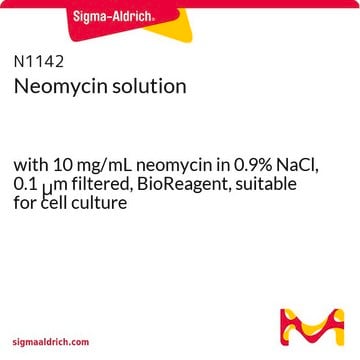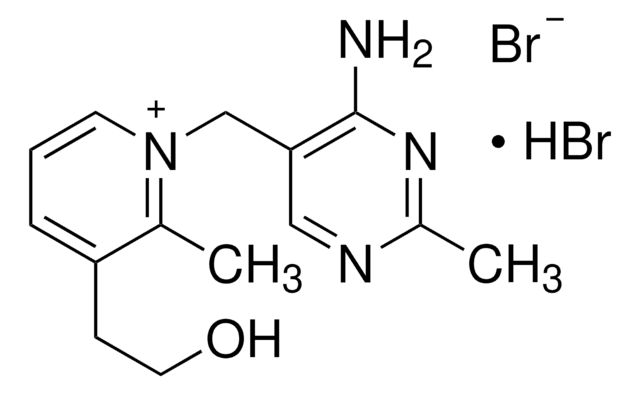推荐产品
生物来源
Streptomyces hygroscopicus
无菌性
non-sterile; 0.2 μm filtered
方案
80% (HPLC)
表单
buffered aqueous solution
组成
Hygromycin B, >80% HPLC
包装
pkg of 20 mL (1 g)
制造商/商品名称
Roche
浓度
50 mg/mL
技术
transfection: suitable
SMILES字符串
CN[C@H]1C[C@@H](N)[C@H](O)[C@@H](O[C@@H]2O[C@H](CO)[C@H](O)[C@@H]3O[C@]4(O[C@H]([C@H](N)CO)[C@H](O)[C@H](O)[C@H]4O)O[C@H]23)[C@@H]1O
InChI
1S/C20H37N3O13/c1-23-7-2-5(21)9(26)15(10(7)27)33-19-17-16(11(28)8(4-25)32-19)35-20(36-17)18(31)13(30)12(29)14(34-20)6(22)3-24/h5-19,23-31H,2-4,21-22H2,1H3/t5-,6-,7+,8-,9+,10-,11+,12-,13+,14-,15-,16+,17+,18-,19+,20+/m1/s1
InChI key
GRRNUXAQVGOGFE-XKIAHZFYSA-N
正在寻找类似产品? 访问 产品对比指南
相关类别
一般描述
- 分子式:C20H37N3O13
- LD50: 小鼠6 mg/kg(静脉注射);豚鼠13 mg/kg(腹腔注射); 大鼠63 mg/kg (腹腔注射)
- 分子量:Mr = 527.5
- 工作浓度:细胞培养中50 - 1,000 μg/ml。用于选择哺乳动物细胞的常用浓度是 200μ g/ml。。但是,最佳浓度必须通过实验确定,因为它可能会因使用的细胞类型而异。
应用
生化/生理作用
抗菌谱:潮霉素B对细菌、真菌和高等真核细胞有抑制作用。
质量
单位定义
我们没有这些信息。
外形
制备说明
储存及稳定性
其他说明
警示用语:
Danger
危险分类
Acute Tox. 1 Inhalation - Acute Tox. 3 Oral - Acute Tox. 4 Dermal - Eye Dam. 1 - Resp. Sens. 1 - Skin Sens. 1
储存分类代码
6.1D - Non-combustible acute toxic Cat.3 / toxic hazardous materials or hazardous materials causing chronic effects
WGK
WGK 1
闪点(°F)
does not flash
闪点(°C)
does not flash
其他客户在看
商品
Antibiotic kill curve is a dose response experiment in which mammalian cells are subjected to increasing amounts of selection antibiotic
Antibiotic kill curve is a dose response experiment in which mammalian cells are subjected to increasing amounts of selection antibiotic
Antibiotic kill curve is a dose response experiment in which mammalian cells are subjected to increasing amounts of selection antibiotic
Antibiotic kill curve is a dose response experiment in which mammalian cells are subjected to increasing amounts of selection antibiotic
我们的科学家团队拥有各种研究领域经验,包括生命科学、材料科学、化学合成、色谱、分析及许多其他领域.
联系客户支持









